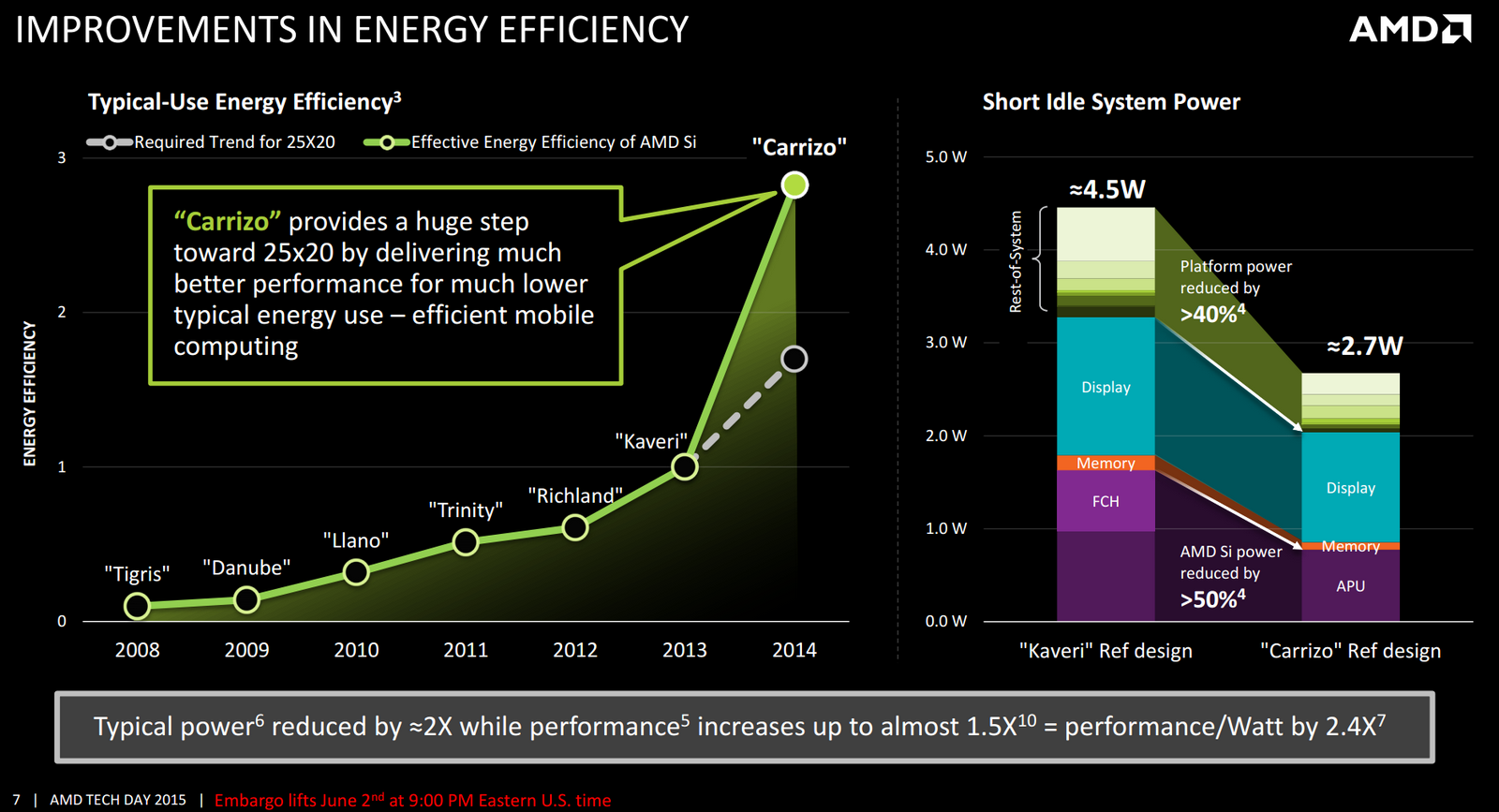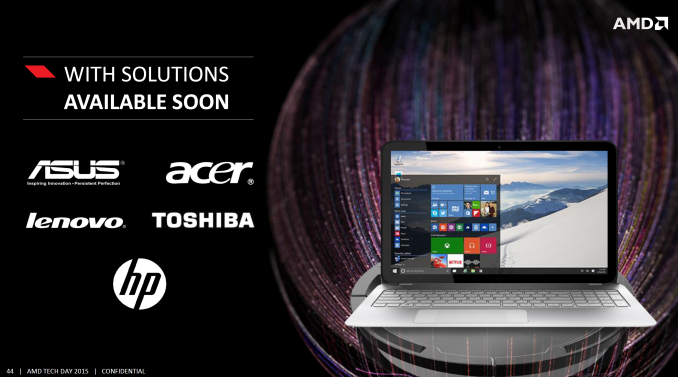Who Controls the User Experience? AMD’s Carrizo Thoroughly Tested
by Ian Cutress on February 4, 2016 8:00 AM ESTHow to Iterate Through Design
While AMD’s Carrizo is still based on this Bulldozer design, it represents the fourth iterative update, called Excavator, which is now produced at the 28nm process node compared to the 32nm original design. At each juncture from Bulldozer (rev1) through Piledriver (rev2) and Steamroller (rev3) to Excavator (rev4), AMDs goal has been the same as most other semiconductor manufacturers - produce a list of fixes that provide the most benefit for the least amount of time, then work through that list. This is not an uncommon procedure for iterative updates, and in itself retains the logical thought of improving the design as much as possible.
What this method perhaps misses are the bigger leaps in design philosophy where shifting fundamental paradigms can have a bigger impact on key properties of the product, but these changes in philosophy often carry the burden of increased risk and cost, where failure is seen as a waste of resources. Nevertheless, the Excavator core and the Carrizo design, according to AMD, implements a significant number of fundamental paradigm shifts compared to previous revisions, and as a result Carrizo behaves differently in a large number of key metrics. The base design underneath is still inherently the Bulldozer concept, however the 'skunkworks' style adjustments, according to AMD, significantly improve the power consumption, the single core performance and the potential battery life over previous AMD processor designs in mobile segments. All current gains on this design have only come from AMD, lacking independent verification.
For a more detailed look at AMD's Excavator design, with high density libraries and power management, read our run down of Carrizo's technology from our launch article here.
Gaining OEM Support
Aside from the processor itself, the image of AMD based devices, especially in the mobile segment, is not overly positive. As mentioned above, there are two sides to this story - original equipment manufacturers whom use AMD processors in their designs have to be confident that it will provide a level of performance suitable for the experience they expect the consumer to have. Similarly, the end user must also receive a platform that benefits the price point purchased and retains a level of quality consistent with providing a good experience. Former poor experiences can be a heavily influence in future purchasing decisions, and those with a negative opinion require a fundamental design change or significant external recommendations in order to make a change against a gut feeling. If a user keeps getting a poor design, regardless of which side of the fence is responsible (or both), both will be negatively affected, and sometimes one more than the other.
This applies to both consumers and business users, the latter of which is often down to individuals at companies making recommendations based on brand and business sense. If a business buyer insists on Dell, for example due to a long term support contract, they will source the most appropriate Dell device out of the range based on research and that gut feeling. In order for a semiconductor company to be competitive in this space, they need to work closely and extensively with the business OEMs to build devices that facilitate the experiences required with a level of industrial design that enables the appropriate experience. It is not difficult to search online for details of users that are disgruntled with devices from both Intel and AMD, particularly in areas such as industrial design of the device, performance, battery life, temperature and quality.
While Intel has a number of arms with partners based on the success of the Core architcture over the last decade, AMD’s stable of partners is not so large. AMD has three top tier partners – HP, Lenovo and Toshiba – all of whom are represented in this report. Like many other notebook manufacturers in the industry, all of these three are well known for some models but hounded on others, especially those at the bottom of the price stack or due to unique sets of security principles. As mentioned previously, HP focuses a lot on the Enterprise space with items like the Elitebook line, but if personal experience is anything to go by, consumer use of Elitebooks has declined. Toshiba meanwhile suffers from the race-to-the-bottom syndrome where sometimes a simple $30 upgrade can make the difference, and Lenovo’s recent software issues have been well documented. AMD works with these three partners the most, such that when they score a big contract (such as 30,000 units with HP for Dr. Pepper/Snapple) it is actually a big contract for AMD.












175 Comments
View All Comments
jakemonO - Wednesday, February 10, 2016 - link
no A12 core parts for the test? I can't find the A10 part on the HP websiote, only A8 & A12UtilityMax - Wednesday, February 10, 2016 - link
After a decade of hype since the ATI acquisition, nothing has changed. AMD has a massive OEM problem. Moreover, laptops have been outselling desktops for like a decade, yet AMD if you look at the history of AMD, it's hard to believe they ever really cared about portables. The Kaveri parts didn't even show up, while the Carrizo notebooks are already botched technology as explained in the article..gserli - Thursday, February 11, 2016 - link
I have to say that the $400 to $700 notebooks on sale are garbage.The IGPs are not strong enough for casual gaming like LOL and CS GO.
Crappy 5400RPM harddisk will make you want to throw the machine out of the window.
If you really need that little bit more performance.
Pay few hundred more. Or you can get a notebook that will hurt your arm if you carry it with one hand.
AMD needs to be more aggressive. Talk to the OEMs and give them better offer.
Convince them build a $700 notebook with 13 Inch 1080p IPS touch screen, 256GB SSD, 8GB RAM, A8 or A6 APU and below 1.5KG.
A lower end $600 one would work with 1366*768 IPS touch screen, 128GB SSD, 4GB RAM and A6 APU, below 1.5KG.
My $640 Asus TP300L is absolutely bullshit! I thought a mobile i5 would be enough for my daily use since I had a i5 desktop and was really satisfied with it.
CPU performance is not a issue nowadays. The IGP is slow, but I didn't expect it to be fast(Although the one on desktop is way more powerful).
The biggest problem is the GOD DAMN 5400RPM HARD DISK.
Not only did it affect the boot up speed. Every action I performed is awfully slow when there are some OS things running in background.
Only if I wait for 5 or 10 minutes after boot-up, then I can use it normally.
Please, kill all the 5400RPM Hard disk. They should not be in 2016.
farmergann - Thursday, February 11, 2016 - link
That's what I find so hilarious about all the Y700 6700hq lovers out there - all the CPU power in the world is relegated to potato status outside of b.s. benchmarks with that 5400rpm HDD. Save money with the FX8800p Y700 and buy an $80 250GB Samsung 850 Evo to slap in it...wow&wow - Thursday, February 11, 2016 - link
Will it be more appropriate to have "Additional" (Why not Update?) in the beginning, particularly the misleading pre-production stuff? Thanks for the article.farmergann - Thursday, February 11, 2016 - link
LOL, because the entire point of this article would be nullified. They didn't even bother comparing the FX8800p Y700 with the intels head to head outside of some DX9 garbage. Pitiful anandtech shills are pitiful. How many times did they mention Freesync? Yeah...silverblue - Friday, February 12, 2016 - link
To be fair, is there a point?xrror - Thursday, February 11, 2016 - link
"Some companies in the past have dealt with contra-revenue, selling processors at below cost or with deals on multiple parts when purchased together. Very few companies, typically ones with large market shares in other areas, have access to this. Some members of the industry also see it as not fighting fair, compared to actually just pricing the parts lower in the first place."I had to laugh so much as this. WHO COULD IT BE? MYSTERY!
It must be... Cyrix ! no? hrm. I give up. =P
dustwalker13 - Saturday, February 13, 2016 - link
still ... there is just no saving the bulldozer architecture, no matter how much they improve or iterate it.bulldozer and amd by proxy for normal users are synonyms for "just not as good as intel" and for a little more experienced users "that processor that cheated with its core count".
the few people who actually read articles like the one above and compare performance/value represent literally no market share.
the only way out for amd at this point is to create as much boom around their zen-cores as possible, get them out asap, hitch their little start to new buzzwords like hbm, old buzzwords like rage and hope they can actually deliver the performance figures needed in the first reviews to drive a wave of positive articles through the press. only then will they be able to get back into the market. i wish them the best, a surface 5 (non pro) with a low power zen apu on hbm sounds awsome ... i'd get one of those in a heartbeat.
yankeeDDL - Monday, February 15, 2016 - link
I own a Toshiba P50D-C-104. I read with interest this article and, albeit extremely helpful and rich of information, left some questions open, at least as far a I'm concerned.First of all, the P50D-C-104 costs <$600 and has an A10-8700P. I find this price range more relevant for home-users and, in general, for somebody interested in AMD offering.
1Kusd for a laptop with integrated GPU seems too expensive.
The P50D-C-104 has 2 DIMM slots; couldn't find for sure whether it is dual channel or not.
I am curios to know how it performs on some popular games against Intel's offering (at that price level, it would go against core i3, at best). In the page with comparison against Intel's offering there are almost only synthetic benchmarks: it would have been nice to compare on some actual games.
My point is that in the $1K range, there are many features that could add cost while not necessarily improving performance.